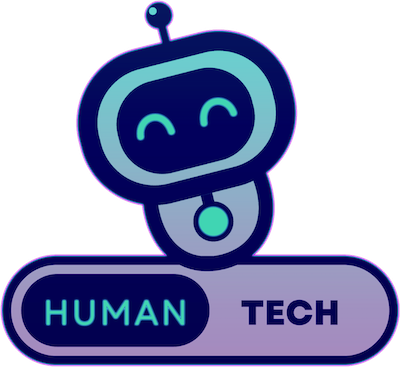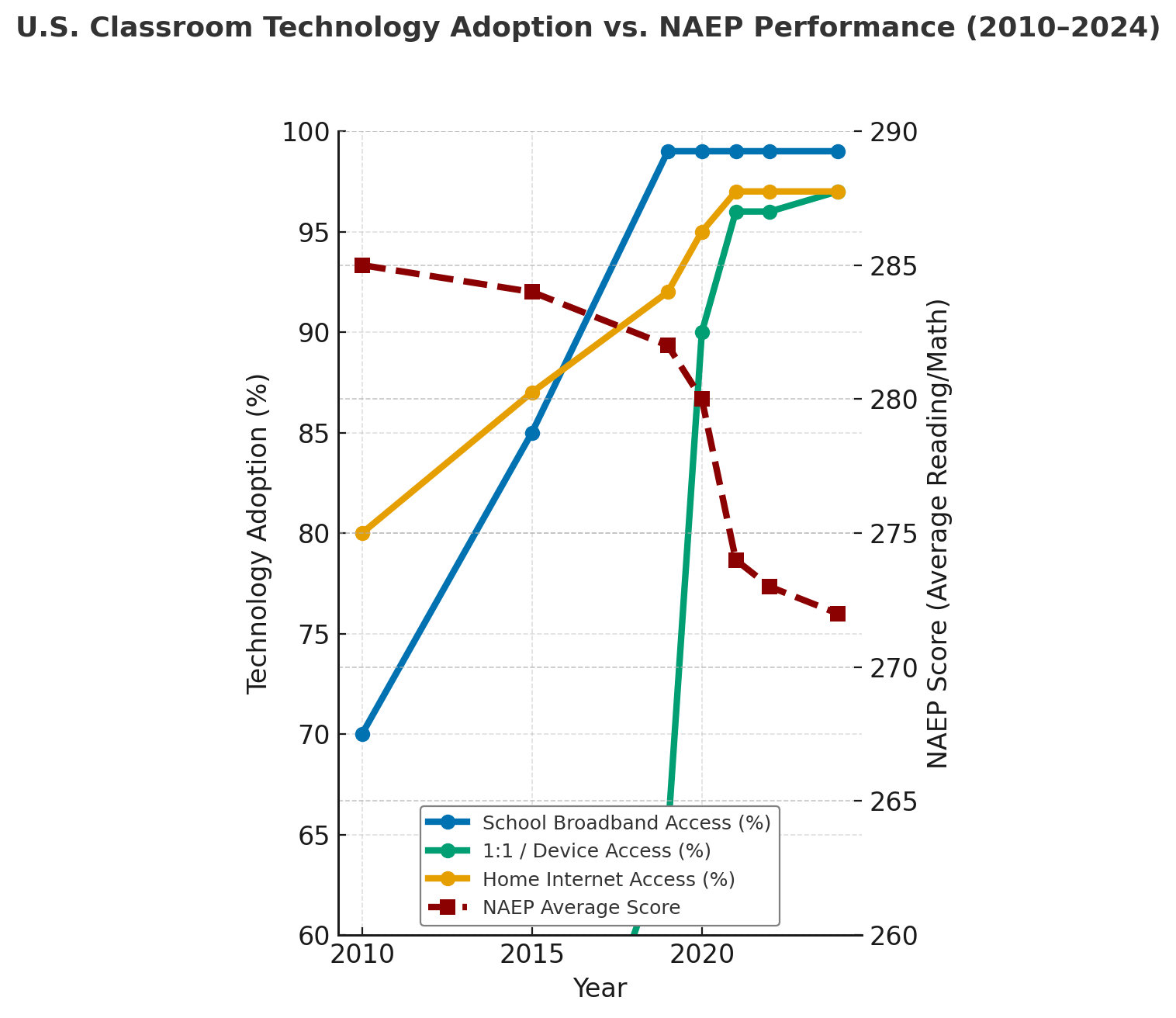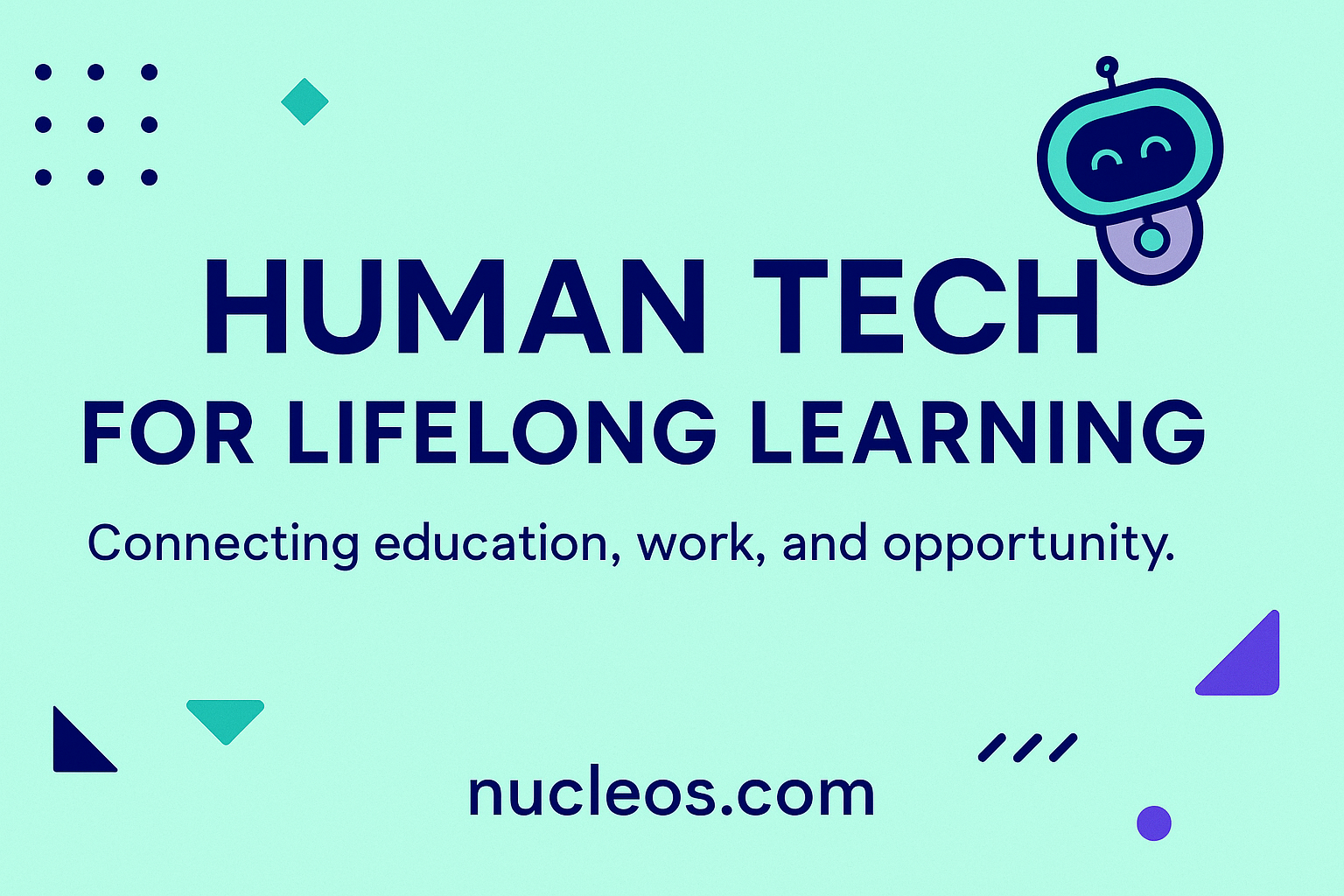Declining Grades on the Nation’s Report Card - How Can We Ensure Technology is a Help Not a Hindrance?


This article is part of our Fall 2025 Newsletter.
When the latest Nation’s Report Card (NAEP) results were released, the headlines were stark: American students’ reading and math scores have fallen to their lowest levels in decades. For more than 50 years, the National Assessment of Educational Progress (NAEP) - the Nation’s Report Card- has been America’s most trusted measure of student learning. But the 2024 results tell a sobering story. Fourth- and eighth-grade reading and math scores have fallen to their lowest levels in decades, with nearly 40% of students now performing below “Basic.” Math declines were the steepest in NAEP history: an 11-point drop in eighth grade since 2013 erased three decades of progress. Science, civics, and U.S. history scores also fell, revealing that fewer students can explain how government works or demonstrate grade-level mastery of key skills. Despite historic investments in technology and resources, fewer students are thriving academically than at any point in a generation.
Even as academic performance has faltered, schools have undergone a technological transformation. The past decade - and the pandemic in particular - ushered in unprecedented investment in educational technology. By 2021, many districts achieved one-to-one device programs (a laptop or tablet for every student) and expanded internet connectivity for remote learning. The 2024 National Education Technology Plan (NETP) reports that U.S. schools now have greater connectivity and device access than ever before, thanks to the emergency remote learning push . This massive leap in closing the “digital access divide” means that, in principle, more students can get online and use digital tools daily in school. Yet despite unprecedented access to digital tools, national learning outcomes have not improved. The gains in connectivity simply haven’t translated into gains in achievement.
Over the past ten years, the United States has achieved one of the most sweeping expansions of digital access in history. By 2019, 99% of schools were connected to high-speed broadband1; 96% of public schools were providing devices directly to students2; and by 2021, 97% of children had home internet access3. From a purely technological standpoint, we’ve never been more connected. And yet, NAEP scores have shown a pronounced decline.
The natural question to ask is, “Has technology failed our classrooms?”. Simply flooding classrooms with devices doesn’t automatically improve learning. In fact, the NETP warns that if technology is not implemented thoughtfully, it can fall short or even backfire. From a purely technological standpoint, we’ve never been more connected. And yet, NAEP scores declined, even as tech adoption soared. That paradox demands a deeper look, not just at devices and connectivity, but at how we use them.

Technology Has Caught Up. Will Learning Gains Follow?
The problem is not just access to technology; it’s also access to meaningful learning experiences. The first digital divide - access to devices, Wi-Fi, and bandwidth - has largely been bridged in traditional learning environments. For these learners, the next divide is about agency: who gets to use technology to grow, adapt, and participate fully in modern life.
At Nucleos, we call this shift Human Tech: technology that empowers people rather than replaces them. Tools alone don’t drive learning. Human connection, purpose, and agency do. The real promise of digital education isn’t simply to deliver more content; it’s to make learning personal, portable, and human again.
The Two Divides: Access and Agency
As we look across America’s learning landscape, we see two very different realities - both urgent, both intertwined.
Digital Divide #1: Access
Where it persists: Correctional facilities, rural areas, disconnected populations
Barrier: Connectivity, devices, high-quality learning programs leading to degrees, diplomas, or industry-recognized credentials
Goal: “Get connected.”
Nucleos focus: Secure access, equitable delivery
Digital Divide #2: Agency
Where it’s emerging: Mainstream adult education, workforce programs, public schools
Barrier: Fragmented systems, lack of personalization or purpose
Goal: “Get empowered.”
Nucleos focus: Adaptive learning, AI coaching, career pathways
Behind the Walls: The Access Divide That Still Persists
While the rest of the country has moved into the agency era, millions of incarcerated learners remain on the wrong side of the first divide.
A national survey by Ithaka S+R (2022) found that:
- 24% of higher-education-in-prison programs report that students have no access to any device for coursework.
- 66% say their students have no internet access at all, even for approved educational use.
- Only 15% use local networks or secure WAN systems to deliver digital learning.
Even where technology is present in correctional education, it’s often heavily restricted - limited to apps on offline servers, devices from telecom companies that limit access to education to as little as 15 minutes per day, out-of-date hardware, or shared computer labs with limited hours.
As one program director told researchers, “Our students can’t even open a browser to check their syllabus. Everything is printed, pre-loaded, or locked down.”
That means learning in these environments happens with one hand tied behind the back. And yet, the demand for education and reentry preparation has never been higher.
The Ford School’s 2025 “Ensuring Educational Technology Access for Incarcerated Students” brief captured the moment perfectly:
“As Pell reinstatement opens the door for more college-in-prison programs, technology access remains the key that many systems still refuse to turn.”
In these settings, education technology isn’t about convenience; it’s about restoring basic participation in the modern learning economy. That’s where Nucleos’ work begins.
Building Access That Builds Agency
Through AchieveDXP, Nucleos delivers secure, cloud-connected learning environments tailored for correctional education.
Our goal isn’t simply to provide technology, but to make technology usable - safe, monitored, and empowering for both educators and learners.
Inside prison systems in places like Wyoming, the Virgin Islands, and Hawaii, Nucleos has built digital classrooms that enable learners to complete GEDs, vocational certificates, and college courses on devices that meet stringent security requirements.
These deployments demonstrate that access and agency are not opposites -they are stages of the same continuum. Once access is established, learners begin to take ownership: completing courses, tracking progress, and exploring new career goals.
The transformation we see daily is profound. A learner who once had zero internet access can now earn an industry-recognized credential, connect with a virtual instructor, and walk out with a verified learning record that carries into reentry programs or community college.
Beyond the Walls: The Agency Gap in Adult Education
Outside correctional systems, the story flips. Devices and the internet are nearly universal - but too often, learners face fragmented experiences across apps, platforms, and programs.
A student may take literacy classes through one system, workforce training through another, and community college through a third, with no unified record or coaching layer to help them make sense of it all. The result: progress that’s disconnected from opportunity.
Here, AchieveDXP functions as a bridge: a single digital experience platform that unifies learning records, connects instructors and mentors, and powers AI-driven tools like our upcoming Career Coach, which helps learners translate what they’ve learned into tangible career goals.
When we talk about the next digital divide, this is it:
not access to the network, but access to navigation - a way for learners to see where they are and where they can go next.
What the Nation’s Report Card Really Tells Us
The decline in NAEP scores doesn’t prove that technology has failed. It proves that access alone isn’t enough.
We’ve connected nearly every school, yet many students are still disconnected from motivation, meaning, and mastery. Teachers are over-extended. Systems are siloed. Technology is abundant but fragmented.
If we want to reverse those trends, we have to move from a device-driven model to a human-driven model - from distribution to design, from access to agency.
Human Tech isn’t about more screens. It’s about making every digital interaction more purposeful, more personalized, and more empowering for learners and educators alike.
The Road Ahead
If the last decade was about closing the access gap, the next must be about closing the agency gap.
- Inside correctional systems, that means guaranteeing every learner the right to modern tools and secure digital learning.
- In adult education and workforce systems, it means re-designing those tools to foster agency, continuity, and personal growth.
The stakes are bigger than test scores. They’re about whether technology serves human potential - or merely digitizes inequality.
Conclusion: Human Tech as the Common Ground
When the history of this moment is written, we won’t be judged by how many devices we distributed, but by what people were able to do with them.
That’s the vision behind Human Tech, and the mission of Nucleos:
to ensure that technology in education - whether in a prison classroom or an online workforce lab - works in service of human progress.
The upcoming Brick x Brick Reentry Conference embodies this approach - uniting educators, advocates, and returning citizens to turn ideas about access and agency into shared action. As we come together at Brick by Brick, and as our nation wrestles with the meaning of its own report card, one truth remains clear: the future of learning isn’t about access or algorithms.
It’s about people.
Brick by brick, and learner by learner, we’re building that future.
1 EducationSuperHighway stated in its “The classroom connectivity gap is closed” report that 99% of America’s K-12 public schools now have fiber or high-speed broadband connections
2 The NCES “Technology Support” report states: “By the beginning of the 2021-22 school year, almost all public schools (96 percent) reported providing digital devices to their students who needed them
3 NCES “Children’s Internet Access at Home” reports: “In 2021, some 97 percent of 3- to 18-year-olds had home internet access” by computer or smartphone

.svg)





.jpg)


.svg)
.svg)
.svg)

.svg)
.svg)